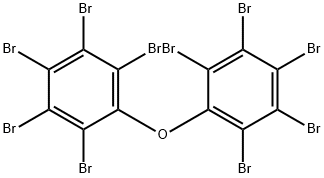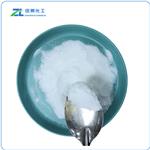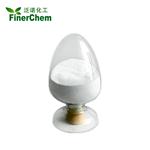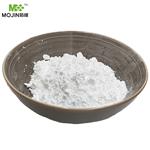Description
DBDPO is a white to off-white powder.Molecular weight = 959.9. Hazard Identification (based onNFPA-704 M Rating System): Health 2, Flammability 0,Reactivity 0. Slightly soluble in water.
Chemical Properties
Decabromodiphenyl Oxide (DBDPO) is a white to off-white or light yellow powder. Almost insoluble in all solvents. Good thermal stability. Heated to 354 ℃, weight loss 5%. It is a non-toxic and non-polluting flame retardant.
Uses
Decabromodiphenyl ether is a brominated flame retardant that is used in conjunction with antimony trioxide in high impact polystyrene. DecaBDE is used as an additive flame retardant, and has a variety of applications including in plastics/polymers/composites, textiles, adhesives, sealants, coatings and inks. DecaBDE containing plastics are used in housings of computers and TVs, wires and cables, pipes and carpets. Adverse effects are reported for soil organisms, birds, fish, frog, rat, mice and humans. One of the new POPs under the Stockholm Convention
Definition
ChEBI: Decabromodiphenyl ether is a polybromodiphenyl ether that is diphenyl ether in which all of the hydrogens have been replaced by bromines. It has a role as a neurotoxin.
Application
Decabromodiphenyl oxide is an unreactive, additive flame retardant widely used for its thermal stability and its low cost in thermoplastic resins, thermoset resins, textiles and adhesives. The major applications are in high impact polystyrene, glass reinforced thermoplastic polyester and moulding resins, low density polyethylene extrusion coatings, polypropylene (homo- and copolymers), acrylonitrile butadiene styrene rubber, nylon and polyvinyl chloride.
Preparation
Decabromodiphenyl ether can be synthesized by reacting diphenyl ether with bromine in the presence of halogenated catalyst (iron powder, etc.).
The diphenyl ether is dissolved in the solvent, the catalyst is added, and then bromine is added to carry out the reaction. After the reaction, filter, wash and dry to obtain decabromodiphenyl ether. Commonly used solvents are dibromoethane, dichloroethane, dibromomethane, carbon tetrachloride, tetrachloroethane and the like.
General Description
White to off-white powder with a chemical odor.
Air & Water Reactions
Insoluble in water.
Reactivity Profile
Decabromodiphenyl oxide is incompatible with strong oxidizers .
Fire Hazard
Flash point data for Decabromodiphenyl oxide are not available; however, Decabromodiphenyl oxide is probably combustible.
Safety Profile
Questionable carcinogen with experimental neoplastigenic data. Experimental reproductive effects. Used as a flame retardant for thermoplastics. When heated to decomposition it emits toxic fumes of Br-. See also ETHERS and BROMIDES
Potential Exposure
It is used as a fire retardant for
thermoplastics and man-made fibers.
First aid
If this chemical gets into the eyes, remove anycontact lenses at once and irrigate immediately for at least15 min, occasionally lifting upper and lower lids. Seek medical attention immediately. If this chemical contacts theskin, remove contaminated clothing and wash immediatelywith soap and water. Seek medical attention immediately. Ifthis chemical has been inhaled, remove from exposure,begin rescue breathing (using universal precautions, including resuscitation mask) if breathing has stopped and CPR ifheart action has stopped. Transfer promptly to a medicalfacility. When this chemical has been swallowed, get medical attention. Give large quantities of water and inducevomiting. Do not make an unconscious person vomit.
storage
Color Code—Green: General storage may be used.Prior to working with DPDPO you should be trained on itsproper handling and storage. Store in tightly closed containers in a cool, well-ventilated area away from strong oxidizers.Where possible, automatically transfer this chemical fromdrums or other storage containers to process containers. Useonly nonsparking tools and equipment, especially when opening and closing containers of this chemical. Sources of ignition, such as smoking and open flames, are prohibited wherethis chemical is used, handled, or stored in a manner thatcould create a potential fire or explosion hazard. Whereverthis chemical is used, handled, manufactured, or stored, useexplosion-proof electrical equipment and fittings.
Shipping
UN3077 Environmentally hazardous substances,
solid, n.o.s., Hazard class: 9; Labels: 9-Miscellaneous
hazardous material, Technical Name Required. UN3152
Polyhalogenated biphenyls, solid or Polyhalogenated ter-
phenyls, solid, Hazard class: 9; Labels: 9-Miscellaneous
hazardous material.
Incompatibilities
Incompatible with strong oxidizers (chlo-
rates, nitrates, peroxides, permanganates, perchlorates,
chlorine, bromine, fluorine, etc.); contact may cause fires
or explosions. Keep away from alkaline materials, strong
bases, strong acids, oxoacids, and epoxides. Ethers have
a tendency to form unstable and explosive peroxides.
Toxics Screening Level
The Initial Threshold Screening Level (ITSL) for decabromodiphenyl ether (DBDPE) is
25 μg/m3 with 24-hr averaging time. The Initial Risk Screening Level (IRSL) for
DBDPE is 5 μg/m3 and the Secondary Risk Screening Level (SRSL) is 50 μg/m3; both
with annual averaging time.








